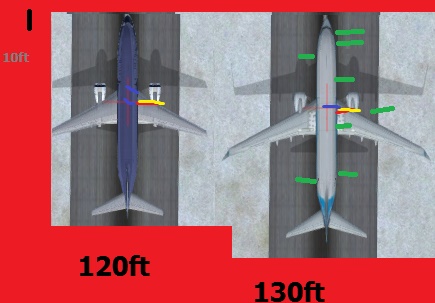the imported heavies from FS2002, like the Boeing 734-400 and the 777-300 do not have, by default, any load position in their aircraft.cfg file. Such stations allow to determine, before a flight, in the Fuel and Payload menu, the passenger payload of a give plane. At the price of some try-and-fail process, it is easy to endow those planes with the same possibilities as their FSX counterparts. The process is just to take in consideration the payload stations passage in the aircraft.cfg file of both the 737-800 and the 747-400 planes and to work it into the imported craft aircraft.cfg file. The first one is to be fitted to 737-400-type planes and the second to larger heavies, like the 77-300, for example. The aircraft.cfg file for a plane is to be found in the plane main folder, which itself is usually found at the path C:\Program Files (x86)\Microsoft Games\Microsoft Flight Simulator X\SimObjects\Airplanes. In there, just look for the payload station passages, which are of the type:
reference_datum_position = 0, 0, 0 // (feet) distance from FlightSim Reference position: (1/4 chord, centerline, waterline)
empty_weight_CG_position = -9, 0, 0 // (feet) longitudinal, lateral, vertical distance from specified datum
max_number_of_stations = 50
station_load.0 = 17.0, 46.3, -1.5, 0.0 //Weight (lbs), longitudinal, lateral, vertical positions from datum (feet) 170.0
station_load.1 = 170.0, 46.3, 1.5, 0.0 //Weight (lbs), longitudinal, lateral, vertical positions from datum (feet) 170.0
etc.
station_name.0 = "Pilot"
station_name.1 = "Co-Pilot"
etc.
each station is representing a main payload item and location, like the deck, or the passengers cabin, for example. The 'reference_datum_position' is whence the stations are calculated in terms of their position (the 'empty_weight_CG_position,' as far as it is concerned, is determining whence the varied loads installed for a given flight will impact the center of gravity of the plane). Thence, it is easy to modify the payload stations of a Boeing 737-800 to a small heavy, or that of a Boeing 747-400 to a large one. The best is first to get into FSX and to take pictures (via the screeshot function of your operating system) of both planes -the reference one and the one to modify- on a given location, at the same zoom in the Aerial View view. Just paste both into a single file, like a reference. With the data given in the aircraft.cfg file of the plane you intend to take like a model (the Boeing 737-800 for a 737-400, typically), and known that the load stations position (mostly is the longitudinal to be taken in consideration) is calculated, in feet, from the reference datum position, just figure those positions upon the reference plane pic (in green with our illustration). The reference datum position (in yellow in our illustration and maybe slightly misrepresented) typically is located by reference to the first one-quarter of the wing width at the fuselage (and on the centerline). Once done, just copy the load station passages of the reference plane into the aircraft.cfg file of the imported one, at the correct position, AND just modify the position coordinates accordingly! Do not forget also to change the station_name.0 = "Pilot" etc. passages, shoud you have added, or delete one or more of the original load sections list. Once done, you will see how the load stations now appear, for your imported aircraft, into FSX at the Fuel and Payload menu. In case the reference datum position of the reference plane be different of the one in the imported plane, keep the latter (and the same of the center of gravity). In terms of the payload weight reference, you should also alter those, to reflect the values for the imported plane, which sould be done function of the data available to you. Of note, that both the values in the aircraft.cfg file, at:
[WEIGHT_AND_BALANCE]
max_gross_weight = 155500 // (pounds)
empty_weight = 85710 // (pounds)
are the one to which the payload you install into your plane, both the fuel and passengers, are refered to. The empty weight is whence the added weight (fuel and passengers) is calculated, not to exceed the max. gross weight. 170 lbs is the average value for a adult passenger, for example .home page .back Tutorials. Airliners
.home page .back Tutorials. Airliners
